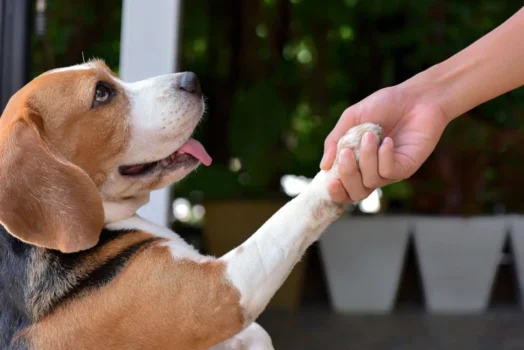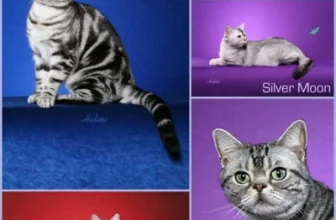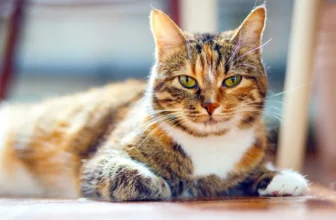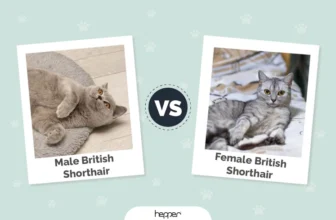It’s not unusual for American Shorthairs to experience anxiety and behavior issues, and as pet owners, it can be challenging to find a solution. Fortunately, positive reinforcement training is an effective approach that can help your furry friend overcome their struggles. But what exactly is positive reinforcement training, and how does it work? And more importantly, what benefits can your American Shorthair experience from this training technique? In this article, we’ll explore these questions and more, so you can take the first step towards building a happier, healthier relationship with your furry companion.
Understanding American Shorthair Anxiety and Behavior Issues

As a pet parent, it’s essential to be aware of potential anxiety and behavior issues in your American Shorthair. These issues can affect your cat’s happiness and quality of life, as well as their relationship with you. Understanding the causes and signs of these issues is the first step in addressing them. By recognizing the early warning signs, and acting proactively, you can help your cat lead a happy, healthy life. In the following sections, we’ll explore the causes and signs of anxiety and behavior issues in American Shorthairs, and how positive reinforcement training can help address them. If you’re interested in learning more about how positive reinforcement training can benefit your cat, you can check out our previous article on Positive Reinforcement Training for American Shorthairs.
The Causes of Anxiety and Behavior Issues in American Shorthairs
American Shorthairs, like any other cat breed, can suffer from anxiety and behavior issues. These problems can be caused by various factors such as environmental changes, health issues, traumas, and even genetics. The following table provides a more detailed overview of the possible causes of anxiety and behavior problems in American Shorthairs:
| Cause of Anxiety and Behavior Issues | Description |
|---|---|
| Environmental changes and stress | Changes in the environment, such as moving to a new house or the introduction of a new family member or pet, can cause stress and anxiety in American Shorthairs. Additionally, loud noises or unexpected situations may cause them to feel uneasy or scared. |
| Health issues | Undiagnosed or untreated health problems, such as urinary tract infections or arthritis, can lead to behavior issues in American Shorthairs. Pain and discomfort resulting from these health issues can cause cats to act out or exhibit unusual behaviors. |
| Trauma and abuse | American Shorthairs that have experienced trauma and abuse in the past may exhibit behavior issues as a result. They may display fear or aggression towards certain people or situations as a protective mechanism. |
| Genetics | Some behavior issues in American Shorthairs may be inherited due to genetics. For example, some cats may be predisposed to certain anxiety disorders or even aggression due to their genetic makeup. |
It’s important to note that each American Shorthair is unique and may exhibit anxiety and behavior issues for different reasons. It’s essential to consult with a veterinarian to determine the underlying cause of the problem and develop an appropriate treatment plan. Positive reinforcement training can be an effective tool for treating anxiety and behavior issues in American Shorthairs, and more information about this will be discussed in the following sections. For those interested in using treats as part of their positive reinforcement training, click here. If you would like information on training an American Shorthair to use a scratching post, check out our article on how to train American Shorthairs to use a scratching post. Finally, to learn about effective positive reinforcement commands for your American Shorthair, click here.
The Signs of Anxiety and Behavior Issues in American Shorthairs
It is important for American Shorthair owners to be aware of the signs of anxiety and behavior issues in their feline friends. By recognizing these signs, owners can identify the problem early on and seek proper treatment. Here are some common signs to look out for:
| Signs of Anxiety and Behavior Issues in American Shorthairs |
|---|
| Excessive grooming – American Shorthairs experiencing anxiety may groom themselves compulsively, leading to hair loss and skin irritation. |
| Aggressive behavior – Anxiety can cause an American Shorthair to act out aggressively by hissing, biting, or scratching. |
| Urinating outside the litter box – A common sign of anxiety, an American Shorthair may avoid using the litter box and instead choose to urinate in inappropriate places. |
| Hiding or avoiding contact – When feeling anxious or stressed, an American Shorthair may retreat and hide to avoid people or other pets. |
| Excessive vocalization – Anxiety can lead to American Shorthairs vocalizing more than usual, meowing excessively or even screaming. |
| Decreased appetite – If an American Shorthair is feeling anxious, they may have a decreased appetite and not eat as much as they usually do. |
It is important to note that these signs can also be indicative of other health issues, so it is important to consult with a veterinarian to accurately diagnose anxiety and behavior issues in American Shorthairs.
The Benefits of Positive Reinforcement Training for American Shorthairs

Positive reinforcement training has been gaining traction as an effective method to address anxiety and behavior issues in pets. American Shorthairs, in particular, can benefit greatly from this type of training. By using positive reinforcement techniques, pet owners can build trust, understanding, and a stronger bond with their American Shorthairs. In this section, we’ll explore the various benefits of positive reinforcement training for American Shorthairs, and how it can help alleviate anxiety and behavior issues in these beloved feline companions.
What is Positive Reinforcement Training?
Positive reinforcement training is a humane and effective method of training animals, including American Shorthairs, that encourages desirable behavior by rewarding it and ignoring or redirecting undesirable behavior. It involves the use of positive stimuli, such as treats, toys, or praise, to shape a cat’s behavior in a way that is both effective and enjoyable. Here are some key features of positive reinforcement training, as well as its advantages and limitations:
| Features of Positive Reinforcement Training | Advantages of Positive Reinforcement Training | Limitations of Positive Reinforcement Training |
|---|---|---|
|
|
|
Positive reinforcement training is a valuable tool for improving your American Shorthair’s behavior and building a stronger relationship with them. By using rewards and positive feedback to encourage good behavior, you can help your cat feel more confident, engaged, and happy.
Why Positive Reinforcement Training is Effective for American Shorthairs with Anxiety and Behavior Issues
Positive reinforcement training is highly effective for American Shorthairs with anxiety and behavior issues. Here are some reasons why:
- It focuses on rewarding desirable behavior: Positive reinforcement training involves rewarding your American Shorthair for exhibiting desirable behaviors, such as sitting or staying. This helps your cat understand what behavior is expected of them and encourages them to repeat that behavior in the future.
- It avoids punishment: Punishing an American Shorthair for undesirable behavior, such as scratching furniture or urinating outside the litter box, can actually increase their anxiety and lead to more unwanted behavior. Positive reinforcement training avoids punishment and instead focuses on reinforcing good behavior.
- It builds trust and confidence: American Shorthairs with anxiety and behavior issues may feel uncertain and fearful in certain situations. Positive reinforcement training helps your cat build trust and confidence by associating positive experiences with those situations. This can help reduce anxiety and improve behavior.
- It promotes mental stimulation: American Shorthairs need mental stimulation and enrichment to be happy and healthy. Positive reinforcement training provides this by challenging your cat to learn new behaviors and respond to cues. This can help reduce anxiety and improve behavior by giving your cat an outlet for their energy and curiosity.
- It strengthens the bond between owner and cat: Positive reinforcement training involves spending time and interacting with your American Shorthair. This can strengthen the bond between you and your cat, which can also help reduce anxiety and improve behavior.
Positive reinforcement training is a compassionate and effective way to improve your American Shorthair’s behavior and reduce their anxiety. By focusing on rewarding desirable behavior, avoiding punishment, building trust and confidence, promoting mental stimulation, and strengthening the bond between owner and cat, positive reinforcement training can help your American Shorthair live a happy, healthy, and well-behaved life.
How Positive Reinforcement Training Changes an American Shorthair’s Brain
Positive reinforcement training has been shown to have a profound effect on the brains of American Shorthairs with anxiety or behavior issues. Here are some of the key ways in which positive reinforcement training can change an American Shorthair’s brain:
- Increased dopamine production: Dopamine is a neurotransmitter that is associated with pleasure, motivation, and learning. When an American Shorthair receives a reward for exhibiting a desired behavior during training, their brain releases dopamine. Over time, this can lead to an increase in dopamine production and a greater likelihood that the American Shorthair will exhibit the desired behavior again in the future.
- Strengthened neural pathways: Positive reinforcement training involves repetition and consistency, which can help to strengthen neural pathways in an American Shorthair’s brain. This means that the desired behavior becomes more automatic and less effortful over time, leading to long-term changes in the American Shorthair’s behavior and thought processes.
- Reduced fear and anxiety: One of the main benefits of positive reinforcement training is that it can help to reduce fear and anxiety in American Shorthairs. When an American Shorthair experiences a positive outcome from exhibiting a desired behavior, their brain starts to associate that behavior with positive outcomes rather than negative ones. This can help to reduce anxiety and fear around certain situations or stimuli.
- Improved problem-solving skills: Positive reinforcement training can also help to improve an American Shorthair’s problem-solving skills. By encouraging an American Shorthair to figure out how to earn a reward, rather than simply performing a behavior because they are told to, positive reinforcement training can help to develop an American Shorthair’s cognitive abilities.
- Increased confidence: When an American Shorthair experiences success during positive reinforcement training, they can start to feel more confident in their abilities. This can lead to a greater willingness to try new things and a decreased fear of failure or mistakes.
Positive reinforcement training can have a wide range of positive effects on an American Shorthair’s brain, ranging from increased dopamine production to improved problem-solving skills and increased confidence. By using positive reinforcement techniques in your training, you can help your American Shorthair to become a happier, more confident, and well-behaved companion.
How Positive Reinforcement Training Builds Trust and Confidence in Your American Shorthair
Positive reinforcement training is a powerful tool in building trust and confidence between you and your American Shorthair. Here are ways that this type of training can strengthen your bond with your cat:
- Creates a Safe Space: By using positive reinforcement, you are teaching your American Shorthair to associate good things with certain behaviors or situations. Over time, this will create a sense of safety and security for your cat, making them more confident in their surroundings.
- Encourages Independent Thinking: Positive reinforcement allows your cat to make choices and learn from the consequences of those choices. This type of training empowers your American Shorthair to think independently, which can boost their confidence.
- Boosts Self-Esteem: As your American Shorthair learns new skills and behaviors through positive reinforcement training, they will feel a sense of accomplishment and pride. This can lead to increased confidence and self-esteem in your cat.
- Strengthens Human-Animal Bond: Positive reinforcement training is an opportunity for you and your American Shorthair to work together towards a common goal. This type of training fosters communication, trust, and mutual understanding between you and your cat, ultimately strengthening your bond.
- Reduces Fear and Anxiety: Anxiety and fear are often linked to a lack of confidence. Positive reinforcement training can help your American Shorthair feel more secure and confident in new and potentially scary situations. This can reduce their overall anxiety and fear levels.
By using positive reinforcement training techniques, you can build a stronger, more trusting relationship with your American Shorthair. This type of training can help boost your cat’s confidence levels and reduce anxiety and fear, ultimately leading to a happier and healthier feline companion.
How Positive Reinforcement Training Forms a Stronger Bond between You and Your American Shorthair
Positive reinforcement training is known for its ability to create a strong bond between American Shorthairs and their owners. This type of training reinforces desired behaviors with rewards, rather than punishing unwanted behaviors. In this way, positive reinforcement training creates a safe and trust-filled environment for your American Shorthair, where it feels comfortable and happy to learn and explore.
One of the key benefits of positive reinforcement training is that it forms a stronger bond between you and your American Shorthair. By using rewards such as treats, playtime, and affection to reinforce good behavior, you form a positive association with your American Shorthair. This association leads to increased trust and respect between you and your pet, and helps build a deep and lasting bond.
Here are some ways that positive reinforcement training can help create a stronger bond:
| Increased Trust and Comfort: | Positive reinforcement training creates a safe and comfortable environment for your American Shorthair, where it feels respected, loved, and valued. This sense of trust and respect leads to a deeper bond between you and your pet. |
| Bonding through Play: | Positive reinforcement training often involves playtime and treats, which are both great ways to bond with your American Shorthair. By playing with your pet and rewarding good behavior, you strengthen your relationship and create happy memories together. |
| Shared Experiences: | Positive reinforcement training creates shared experiences between you and your pet, which help to build a deeper connection. When you work together to learn new behaviors and skills, you create a sense of teamwork and cooperation. |
| Improved Communication: | Positive reinforcement training requires clear communication between you and your American Shorthair. By learning to communicate effectively and positively, you create a deeper understanding and respect for each other. |
In short, positive reinforcement training is not just about teaching your American Shorthair new behaviors; it is about building a deep and lasting bond of trust, respect, and love between you and your pet. By working together and sharing positive experiences, you can create a happy and fulfilling relationship that will last a lifetime.
How Positive Reinforcement Training Provides Mental Stimulation and Enrichment for Your American Shorthair
Positive reinforcement training is not only effective in changing your American Shorthair’s behavior, but it also provides them with mental stimulation and enrichment that can improve their overall well-being. When our pets are left without mental stimulation, they can become bored and develop negative behaviors, such as excessive scratching, meowing, and other destructive habits.
Mental Stimulation through Training
Training your American Shorthair with positive reinforcement exercises can provide daily mental stimulation. When your cat is mentally stimulated, they are more likely to be happy, healthy and well-behaved. As the cat performs the exercises and receives the rewards, its brain processes the actions. This keeps your pet mentally motivated and cognitively active.
Enrichment through Problem-Solving
Enrichment is the process of providing pets with an environment that allows them to engage in problem-solving activities. Positive reinforcement training is designed specifically to provide enrichment for American Shorthairs. Training provides your cat with the opportunity to problem-solve, providing physical and mental challenges that maintain their interest, stimulate their curiosity, and promote their natural instincts.
Incorporating positive reinforcement training into your American Shorthair’s daily routine is an excellent way to provide them with mental stimulation and enrichment. It keeps them engaged physically, mentally, and emotionally, while building stronger bonds between you and your pet.
| Mental Stimulation and Enrichment Techniques for American Shorthairs |
|---|
| Interactive toys that provide mental stimulation |
| Food puzzles and treat dispensers |
| Playing hide-and-seek |
| Training exercises with clicker or target training |
| Agility training to promote problem-solving |
There are many simple and easy-to-implement techniques you can use to provide mental stimulation and enrichment for your cat through positive reinforcement training. Using interactive toys, food puzzles, playing hide-and-seek, and agility training are all effective ways to keep your American Shorthair stimulated and mentally engaged.
Remember, providing mental stimulation and enrichment is critical to your American Shorthair’s overall well-being. Incorporating positive reinforcement training into its daily routine is an effective way to achieve this, promote positive behaviors, and build an unbreakable bond with your cat.
Key Positive Reinforcement Techniques for American Shorthairs
Now that we understand the benefits of positive reinforcement training for American Shorthairs with anxiety or behavior issues, it’s time to explore some key techniques for implementing this type of training. By utilizing these techniques, you can help your cat overcome their challenges and develop new skills while building a stronger bond with them. Let’s take a closer look at some of the most effective positive reinforcement techniques for American Shorthairs, and how they can help your feline friend thrive.
Clicker Training for American Shorthairs
Clicker training is a type of positive reinforcement training that involves using a clicker to signal correct behavior. This can be an effective technique for training American Shorthairs with anxiety or behavior issues because it provides clear and consistent feedback for the cat.
How Clicker Training Works
During clicker training, the cat is taught to associate the sound of the clicker with a reward, such as a treat or praise. The clicker is used to mark the desired behavior, and the reward is given immediately afterwards. This helps to reinforce the behavior and gradually shape it into the desired outcome.
The Benefits of Clicker Training
Clicker training can be particularly effective for American Shorthairs with anxiety or behavior issues because it is a low-stress training method that focuses on positive reinforcement rather than punishment. It can help to build trust and confidence in your cat and create a stronger bond between you and your pet.
Getting Started with Clicker Training
To get started with clicker training, you will need a clicker and some treats. Begin by clicking the clicker and immediately offering your cat a treat. Do this several times so that your cat begins to associate the sound of the clicker with the reward.
Next, start to incorporate the clicker into your training sessions. Click the clicker when your cat does something desirable, such as using the scratching post instead of the couch. Immediately offer a treat as a reward.
Over time, your cat will begin to understand that certain behaviors are associated with the clicker and rewards. You can then start to add commands, such as “sit” or “come,” and click and reward when your cat completes the command correctly.
Important Tips to Remember
– Keep training sessions short and frequent, rather than long and infrequent.
– Be patient and consistent in your training.
– Use high-value treats that your cat loves.
– Only click when your cat has completed the desired behavior, rather than during the behavior itself.
– Always follow the click with a reward.
| Pros | Cons |
| Focuses on positive reinforcement | May require patience and consistency |
| Low-stress training method | Requires the use of a clicker |
| Can build trust and confidence in your cat | May not be effective for all cats |
| Creates a stronger bond between you and your cat |
Clicker training can be a valuable tool for training American Shorthairs with anxiety or behavior issues. It is a low-stress, positive reinforcement training method that can help to build trust, confidence, and a stronger bond between you and your pet.
Target Training for American Shorthairs
Target training is a positive reinforcement technique that can be useful for managing anxiety and behavior issues in American Shorthairs. The goal of target training is to teach your cat to touch a specific target, such as a stick or your hand, with their nose or paw. This can help redirect their attention away from stress triggers and build a positive association with you.
How to Target Train Your American Shorthair
1. Choose a target object: You can use a stick, a pencil, or even your hand as the target object.
2. Introduce the target: Show your cat the target object and let them sniff it. Then, hold it out just far enough for them to reach with their nose or paw.
3. Click and treat: As soon as your cat touches the target object, click a training clicker and give them a treat.
4. Repeat: Repeat this process several times a day, gradually moving the target object farther away from your cat.
5. Add a command: Once your cat is consistently touching the target object, add a verbal command, such as “touch” or “target.”
6. Generalize the behavior: Once your cat is responding to the verbal command, try practicing target training in different locations and with different target objects.
Benefits of Target Training for American Shorthairs
Target training can be particularly useful for American Shorthairs with anxiety or behavior issues because it helps redirect their focus in a positive way. It can also increase their confidence and trust in you as their owner. Additionally, target training provides mental stimulation and enrichment, which can help prevent boredom and destructive behavior. Target training is a fun and effective way to bond with your American Shorthair and improve their well-being.
Feline Agility Training for American Shorthairs
Feline agility training is an excellent way to keep your American Shorthair physically and mentally stimulated. Agility training involves setting up an obstacle course of jumps, tunnels, balance beams, and other challenges for your cat to navigate.
The Benefits of Feline Agility Training for American Shorthairs
Agility training provides numerous benefits for American Shorthairs, including:
| Benefit | Description |
|---|---|
| Physical Exercise | Feline agility training is an excellent source of physical exercise for American Shorthairs. The obstacle course challenges your cat to move and engage their muscles, which helps keep them fit and healthy. |
| Mental Stimulation | Agility training also provides mental stimulation. Your American Shorthair will need to problem-solve and use critical thinking skills to navigate the course successfully. This can help keep them mentally sharp and reduce anxiety. |
| Bonding Time | Agility training is also an excellent opportunity to bond with your American Shorthair. As your cat navigates the obstacle course, you can cheer them on and provide positive reinforcement. This can strengthen the bond between you and your cat. |
How to Get Started with Feline Agility Training
To start agility training with your American Shorthair, you’ll need to set up an obstacle course. You can purchase pre-made agility sets or create your own using household objects like boxes and pillows.
Once you have your obstacle course set up, it’s time to introduce your cat to the course. Start with simple challenges, and gradually increase the difficulty as your American Shorthair becomes more comfortable. Be sure to provide plenty of positive reinforcement and treats to encourage your cat to continue training.
Conclusion
Feline agility training is a great way to keep your American Shorthair physically and mentally stimulated while also providing an opportunity to bond with your cat. By incorporating positive reinforcement techniques into your agility training, you can help your cat build confidence and reduce anxiety.
Other Positive Reinforcement Techniques to Consider
In addition to clicker training, target training, and feline agility training, there are other positive reinforcement techniques that can be used to help American Shorthairs with anxiety and behavior issues.
One such technique is food puzzle toys. Food puzzle toys are a great way to provide mental stimulation and enrichment for your American Shorthair while rewarding them for positive behavior. These toys can be filled with treats or kibble and require your cat to work at getting the food out, which can help reduce stress and anxiety.
Another positive reinforcement technique to consider is desensitization. Desensitization involves slowly exposing your American Shorthair to the things that cause them anxiety or trigger their unwanted behavior, gradually increasing the intensity of exposure over time. This technique can help your cat learn to tolerate and eventually overcome their anxiety or behavior issues.
Environmental enrichment is also important for American Shorthairs with anxiety or behavior issues. This involves providing your cat with a stimulating and engaging environment that meets their physical and emotional needs. This could include things like hiding places, scratching posts, and perches.
Lastly, it’s important to remember to always reward good behavior with praise, treats, or extra playtime. This helps reinforce positive behavior and can help your American Shorthair feel more confident and secure in their environment.
| Positive Reinforcement Technique | Description |
|---|---|
| Food Puzzle Toys | Toys that can be filled with treats or kibble to provide mental stimulation and enrichment. |
| Desensitization | A technique that involves slowly exposing your American Shorthair to the things that cause them anxiety or trigger their unwanted behavior, gradually increasing the intensity of exposure over time. |
| Environmental Enrichment | Providing your cat with a stimulating and engaging environment that meets their physical and emotional needs. This could include things like hiding places, scratching posts, and perches. |
| Rewarding Good Behavior | Reinforcing positive behavior and helping your American Shorthair feel more confident and secure in their environment through praise, treats, or extra playtime. |
Conclusion
In conclusion, it is important to address behavior issues and anxiety in American Shorthair cats with patience and understanding. Rather than resorting to punishment or negative reinforcement, positive reinforcement training offers numerous benefits for both the cat and owner. Through clicker training, target training, and feline agility, owners can build trust and confidence in their American Shorthair while providing mental stimulation and enrichment.
Positive reinforcement training not only addresses behavior issues and anxiety, but also creates a stronger bond between owner and cat. It is a powerful tool for building a positive relationship with your American Shorthair and improving their overall well-being. By providing consistent and positive rewards for desired behaviors, owners can see a significant improvement in their cat’s attitude and behavior.
It is important to remember that positive reinforcement training requires patience and consistency. Each cat is unique and may respond differently, so it is important to tailor the training to your cat’s specific needs. With dedication and a positive attitude, owners can help their American Shorthair overcome anxiety and behavior issues, and form a strong, lasting bond.
Frequently Asked Questions
What is the difference between positive reinforcement and punishment training?
Positive reinforcement focuses on rewarding desired behaviors, while punishment focuses on correcting undesired behaviors. Positive reinforcement is much more effective and humane.
Can American Shorthairs with anxiety ever be completely cured?
While it may not be possible to completely cure anxiety in American Shorthairs, positive reinforcement training can significantly improve their behavior and quality of life.
What are some common signs of anxiety and behavior issues in American Shorthairs?
Some common signs include excessive meowing, hiding, avoiding interactions, aggressive behavior, and refusal to use the litter box.
How long does it take to see improvement in my American Shorthair’s behavior with positive reinforcement training?
This can vary depending on the severity of the behavior issues, but it is common to see improvement within a few weeks to a few months of consistent positive reinforcement training.
Do I need to hire a professional trainer for positive reinforcement training?
While it can be helpful to work with a professional trainer, it is also possible to learn and implement positive reinforcement training techniques on your own with proper research and practice.
What are some recommended treats to use for positive reinforcement training with American Shorthairs?
High-value treats such as small pieces of chicken, freeze-dried meat, or low-sodium tuna can be effective for positive reinforcement training.
Is it ever too late to start positive reinforcement training with an older American Shorthair?
No, it is never too late to start positive reinforcement training with an older American Shorthair. They can still learn and benefit from these techniques.
Can positive reinforcement training be used for other breeds of cats with anxiety and behavior issues?
Yes, positive reinforcement training can be effective for other breeds of cats with anxiety and behavior issues.
Can positive reinforcement training be used for other types of pets, such as dogs or rabbits?
Yes, positive reinforcement training can be effective for other types of pets as well.
Is it possible to overuse positive reinforcement training and spoil my American Shorthair?
No, it is not possible to overuse positive reinforcement training. Consistent, positive reinforcement can actually build a stronger bond between you and your American Shorthair.







